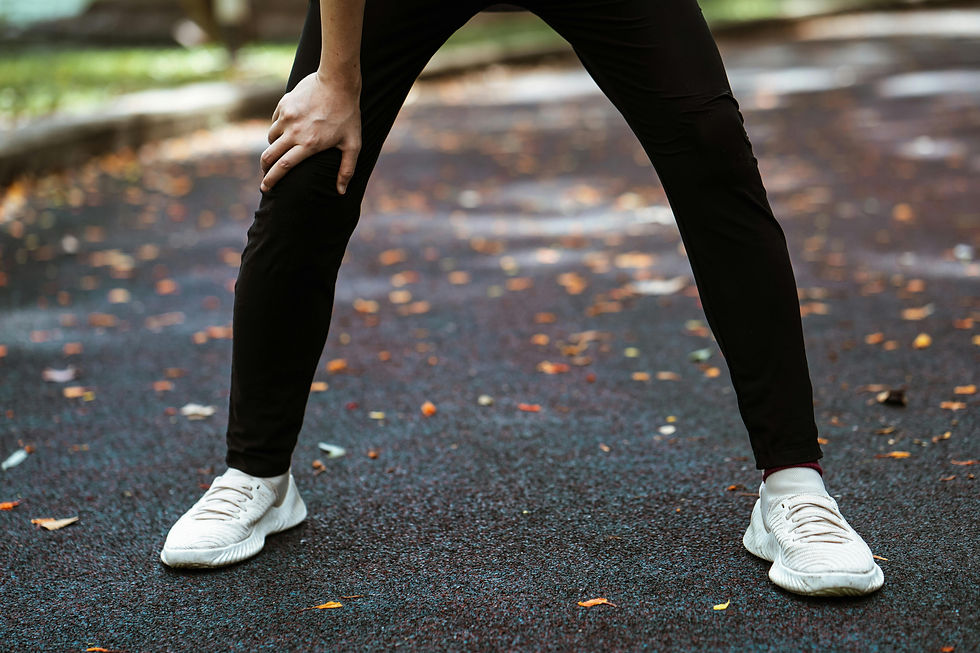Reasons Why Sports & Remedial Massage would Benefit Long-Distance Runners
- Rina Herenius

- Sep 23
- 4 min read
“Running is a sport that can change your life! There is a place for anyone and everyone!"
Gerda Steyn (https://www.facebook.com/gerdarun)

Targeted sports massage can contribute to running more efficiently and recovering from an event more quickly. Pre-event massage promotes endurance and performance; post-event massage reduces pain and enhances recovery.
The Rigours Long-distance Running Imposes on the Human Body
Training for and performing in long-distance running events places high demands on your body. The long training sessions typically put in by an athlete, the mileage your body clocks in, the repetitive movements over long periods of time, the impact-shocks from feet repetitively striking the running surface, all take a high toll on joints, tendons and muscles.
Sports and remedial massage can make a noticeable difference to your performance and recovery. An individualised and specifically targeted recovery strategy can alleviate stiffness and soreness. Aside from enhancing your performance, a pre-event massage can also reduce vulnerability to injury. To protect your body from the demands of endurance running, sports and remedial massage should be an essential component of your training regime.
What Sports and Remedial Massage Can Do for You
Endurance athletes, including marathoners and ultra-marathoners, regularly log a high amount of kilometres per week. Massage therapy can make a pivotal difference in performance and recovery, By combining various techniques—trigger point therapy, myofascial release and deep tissue work—a properly trained therapist will target connective tissue, overtaxed muscles and tight fascia. Sports and remedial massage will:
1. Enhance Your Performance and Recovery
Accelerate repair and recovery by stimulating blood circulation which will deliver oxygen and nutrients to the overtaxed muscles.
Improve range of motion and flexibility by reducing muscle tension.
Prevent adhesions by breaking down minor scar tissue to maintain efficient, smooth muscle function and movements.
Limits Muscle Fatigue by alleviating Delayed Onset Muscle Soreness (DOMS), enabling you to train harder and more consistently.
2. Prevention and Management of Injury
Problem areas can be detected by a skilled therapist, recognising knots, subtle tensions and areas of weakness before they can develop into full-blown injuries.
Correct muscle imbalances by targeting underused and overused muscles thereby promoting better biomechanics, reducing the stress on joints and lowering the risk of injury.
Soften and break down scar tissue from previous injuries, preventing re-injury and restoring normal muscle function.
Reduced risk of general running injuries such as shin splints, hamstring strains and the dreaded ITB syndrome.
3. Psychological Benefits
Improved mental focus and confidence from a pre-event massage because a well-prepared body frees you to concentrate on the kilometres and not on fears of breakdown and injuries.
Enhanced performance on the day of the event because a well-prepared body wastes less energy by moving more efficiently.
Reduce stress and anxiety before a competition by lowering cortisol (the stress hormone) levels, increasing endorphins and improving overall mood.
4. Rehabilitation
Shorter recovery periods between training sessions which allows you to train consistently without being hampered by tight and sore muscles.
Faster recovery from injuries and a safer return to sport participation by addressing the root cause of an injury and speeding up the healing process.
Reduce pain from specific conditions like muscle strains, tendonitis and ITB syndrome.
Complimentary treatment to physiotherapy, biokinetics, chiropractic, etc.
A Word about DOMS, Lactic Acid and What is the Real Cause of Muscle Soreness
The urban myth that lactic acid is to blame for the day after muscle soreness, persists among many athletes. The truth is that lactic acid will clear from the muscles within hours after exercise. The soreness and stiffness you experience a day or two after an event, intense or unfamiliar exercise, are due to tiny, microscopic tears in your muscle fibres, known as DOMS or Delayed Onset Muscle Soreness.
Sports and remedial massage therefore will not be flushing out any lactic acid. It is already gone by the time you get to your massage therapist. But it will help to manage DOMS. It will support the body’s natural repair process, encourage blood flow and reduce muscle tension.
Make Massage Part of Your Training Regime
You plan your long runs and rest days as well as your nutritional strategies. By incorporating weekly or biweekly massage sessions you will keep your running stronger for longer. Many runners feel that regular massage sessions, even if it is just once or twice a month, substantially improve the way they feel during and after training.
You can:
Schedule a session before a big race to prepare your body and make sure that your muscles are relaxed and balanced.
Book a post event session to reduce muscle stiffness and aid recovery.
Be pro-active. Book regular massages. Don’t wait for pain and discomfort to manifest before taking action.
A few final thoughts
Endurance running is not only about fitness and diet but also about recovery. Massage helps you run better and farther by keeping your muscles healthy, your movements efficient and by keeping the risk of injury low.
Your body deserves the same consideration and attention that you apply to your running schedule, no matter whether you are a serious endurance athlete pushing for a personal best or a meditative runner out for a long run on a Sunday morning.
"It was being a runner that mattered, not how fast or how far I could run. The joy was in the act of running and in the journey, not in the destination."
John Bingham (http://www.johnbingham.com/)


Comments